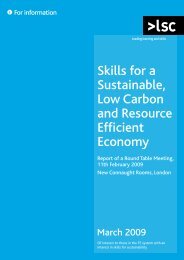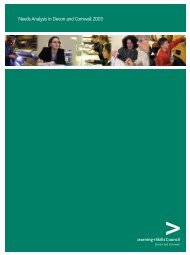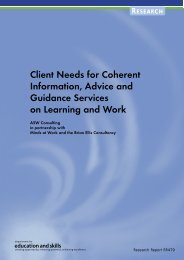Mapping the Big Green Challenge - The Skills & Learning ...
Mapping the Big Green Challenge - The Skills & Learning ...
Mapping the Big Green Challenge - The Skills & Learning ...
You also want an ePaper? Increase the reach of your titles
YUMPU automatically turns print PDFs into web optimized ePapers that Google loves.
<strong>Mapping</strong> <strong>the</strong> <strong>Big</strong> <strong>Green</strong> <strong>Challenge</strong> 151than <strong>the</strong> inclusion of ‘difficult’ areas such as air travel) this proposal might engage more people,although with less impact on carbon reduction goals.Some proposals did try to build <strong>the</strong> idea of intentional, commitment-based groups onto someexisting arena in which people already interacted as a way of enrolling more initially uncommittedpeople. An example of this is <strong>the</strong> proposal by Transition Town Totnes (235) to work with groups ofpeople who already had some social connection (e.g. neighbours, friends, work colleagues) tosupport <strong>the</strong>ir understanding of climate change issues and encourage <strong>the</strong>m to reach <strong>the</strong>ir owndecision about what issues <strong>the</strong>y wanted to commit to and in what ways <strong>the</strong>y wanted to pursue<strong>the</strong>m. Both CRAGs and <strong>the</strong> Transition Town movement achieve an important balance between localdetermination and some wider network for peer learning.A different approach to extending membership based on an individual sharing <strong>the</strong>ir commitmentwith members of <strong>the</strong>ir (possibly uncommitted) personal network can be seen in <strong>the</strong> proposal CarbonPledges (268). This involved individuals obtaining ‘sponsorship’ to reach a commitment to reduce<strong>the</strong>ir carbon footprint. Although this mirrors a traditional fundraising strategy this aspect was notcentral here. <strong>The</strong> emphasis was more on providing a reason to engage friends and family in one’spersonal commitment and its achievement and providing a reason for discussing it with <strong>the</strong>m.An approach to creating commitment within an existing network was suggested in <strong>the</strong> <strong>Big</strong> Mo<strong>the</strong>rProgramme (733) which was aiming to work with students in rented accommodation (a recogniseddifficult area within which to achieve low carbon action). Education about low carbon living wasprovided as were various ‘aids’ (e.g. smart meters and o<strong>the</strong>r equipment, local vegetable boxes). Butto build a sense of a group committed to low carbon goals <strong>the</strong>y proposed a social networking sitewhich would reinforce <strong>the</strong> desirability of being a housemate in a <strong>Big</strong> Mo<strong>the</strong>r household and allowsuch households to compete against each o<strong>the</strong>r.This element of fun and positive ‘rewards’ for achieving <strong>the</strong> goals to which <strong>the</strong> group is committedcan be seen more widely in <strong>the</strong> proposals. Often <strong>the</strong> rewards were primarily symbolic ra<strong>the</strong>r thanmaterially significant. In <strong>the</strong> example above, <strong>the</strong> application did suggest seeking donations fromlocal businesses so that prizes could be awarded but it was <strong>the</strong> competitive element ra<strong>the</strong>r than anysuch prizes that seemed to be central. A similar emphasis on public commitments and achievementsra<strong>the</strong>r than substantive rewards can be seen in <strong>the</strong> proposal New Caledonian Woodlands PlanetPledge Project (187) where involvement in environmental conservation projects was linked togetting people to make a pledge to reduce <strong>the</strong>ir personal carbon emissions. Conservationvolunteers were encouraged to join a ‘planet pledge club’ which provided <strong>the</strong>m with support tomonitor and reduce <strong>the</strong>ir emissions. If <strong>the</strong>y met <strong>the</strong>ir target <strong>the</strong>ir reward was that a native speciestree would be planted in one of <strong>the</strong> <strong>Challenge</strong>r’s new woodlands on <strong>the</strong>ir behalf. Occasional eventscan also be a way of maintaining commitment (and contrariwise of introducing some on-goingelement into <strong>the</strong> ‘events’ approach). <strong>The</strong>se ideas could just be seen as recognition that wider publicpolicy mechanisms such as tax breaks and fines are not options generally available to communitygroups. However <strong>the</strong>y could, alternatively, be seen as more imaginative ways to reinforce positivenorms and behaviour. <strong>The</strong> general absence of negative sanctions in proposals can also be seen as anassessment that positive approaches are more effective ways of maintaining voluntary commitment.Appleby Ltd July 2009











